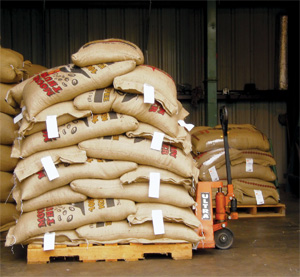IN THE HILLS above Kailua-Kona sits a plantation filled with coffee beans, donkeys, exotic flowers, medicinal tea plants, geese, pigs and a stockroom bursting with powerhouse-industrial coffee-making machinery.
As a cat resembling Morris lounges on a picnic bench next to me, I’m watching an episode of Dirty Jobs, with the hosts visiting this exact location—Mountain Thunder Coffee—and yakking about composted donkey poop with one of the employees. I somehow feel connected with ancient Hawaiian gods.
I’m only irked because I didn’t even realize that Alaska Airlines flies direct to Kona, Hawaii, from San Jose; turns out I didn’t need to go through Honolulu. But all is well. I have a new respect for Alaska Airlines, as well as the San Jose Mineta International Airport. The Big Island of Hawaii is a mythical place if ever there was one, and if Alaska Airlines can help people experience it while simultaneously escaping the confines of San Jose, then that airline shall be commended.
Like champagne, one cannot claim that any coffee is 100 percent Kona unless it’s actually from Kona. If you do, you’re a fraudster. A charlatan. A quack. Throughout the rest of the world, when one sees Kona coffee on the shelf, it’s usually a blend—not the pure stuff. For the real deal, one must journey here, to the heavily forested hills and the misty green shadows of the Big Island’s northwest quadrant. Some of the richest coffee on earth grows here.
Actually getting to Mountain Thunder is an adventure in itself. Located in the Kaloko Cloud Forest of Kona, the plantation seems hidden at first. Two twisting roads—Kaloko Drive and Hao Street—crisscross each other three times, resembling two sine waves 180 degrees out of phase. Driving up Kaloko, one has to remember to “go past the third Hao Street” and turn right to find Mountain Thunder. Whew. There’s a mixed metaphor here somewhere, but I just can’t place it.
After I arrive, John Langenstein, a legend in these parts, effortlessly shepherds me through the cloud forest, swiping branches away from our faces as we navigate the trails. A light drizzle begins to fall. There are donkeys, wild parrots, invasive ginger crops, an ancient lava tube and shimmering spider webs everywhere. I learn more about coffee beans in the span of 20 minutes than I’ll ever be able to remember.
At a clearing, we arrive at a homemade gazebo area overlooking a gigantic coffee orchard spanning the rest of the horizon. Ripe red coffee berries hang from plants everywhere I look. The tour also includes the presence of two loudmouth groups of geese—Toulouse geese and Chinese geese—which always seem to be right in our way, no matter where we go. Their combined squawks make a beautifully horrendous racket.
Langenstein explains that the elevation of this particular part of the Kona area isn’t even that preferable for coffee, compared to other locales, but the folks at Mountain Thunder somehow make it all happen. Unfortunately, I don’t have time for the full tour, which provides a glimpse into the entire coffee process—hand weeding, wet milling, parching, roasting, hulling, sizing, grading and color sorting of the different grades of Kona coffee. Again, this is the real McCoy, not some third-rate blend.
If one has the dough, personalized bags of Cloud Forest Reserve are available for $55 a pound, straight from the industrial roaster and the packaging machine. The bag comes labeled with the customer’s own name, and the batch is not available anywhere else.
That was last September, and after my trip, I vowed to return. Next time, it will have to be on Alaska Airlines.
With that, we end on an even happier note. Just two weeks ago, the first annual Good Food Awards went down in San Francisco. That exact same coffee—Cloud Forest Reserve—was one of the winners in the coffee category. It was Mountain Thunder’s first national award. Mahalo!




